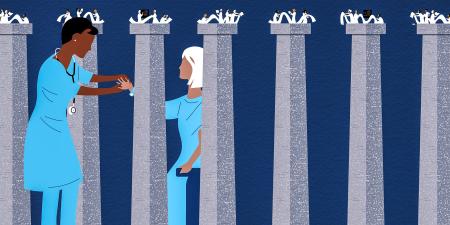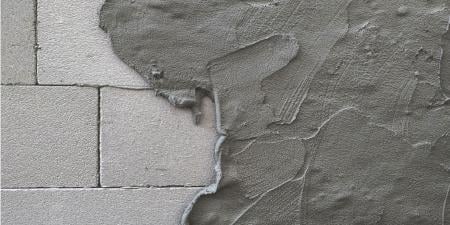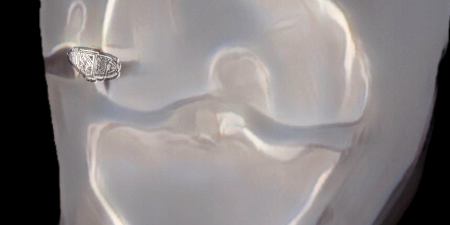Abstract
This article argues that, although efforts to integrate checklists for assessing bias in educational content represent a sincere effort to address or mitigate harm, such efforts will likely have limited (if any) impact on curricular reform or the actual lived experiences of minoritized students. This is because checklists are not designed for justice-oriented assessment and thus will not create the kind of change needed to transform health professions, especially medical education. What is needed is more attention to the ways whiteness is used to organize health professions education and a deep commitment to faculty development focused on raising educators’ critical consciousness.
Introduction
Although efforts to integrate checklists for assessing bias in educational content represent a sincere effort to address or mitigate harm, such efforts will likely have limited (if any) impact on curricular reform or the actual lived experiences of racially and ethnically minoritized students. At best, they signal an important shift among educators toward critical reflection on deeply held beliefs that are transmitted to students through curricular content in ways that eventually impact patient care and also reflect a growing awareness that medicine harbors social injustice in its treatment of race, ethnicity, gender, and other characteristics.1 However, the integration of anti-bias checklists into curricula is of limited value in that such checklists can only serve as a first, and primarily superficial, line of defense for identifying overt instances of stereotyping, bias, shaming, and stigma.2 What is required to transform health professions education is a far more substantial reenvisioning of both pedagogies and curricula and linking them to a justice-oriented system of assessment and evaluation.3
John Rawls argues that social and economic institutions (which include educational institutions) should be “to the greatest benefit of the least advantaged members of society.”4 Using this “difference principle,” we argue that current approaches to curriculum development and assessment, including the widespread integration of anti-bias checklists to ensure inclusivity and fairness, ultimately fail to account for the ways in which power, privilege, and oppression manifest in our curricular and pedagogical assumptions and, as such, continue to benefit those individuals who have historically dominated health professions education. Ultimately, by merely identifying harmful images or language in curricular materials, health professions education treats injustices as incidental rather than structural.
A Justice-Oriented Approach
In place of checklists, we propose a justice-oriented approach to curricular reform and assessment, which centers the needs of marginalized populations in all educational decision making. Whereas checklist questions may ask, Does my curriculum contain an adequate number of images of racially diverse individuals? or Is the language to describe race in my curricula problematic?, a justice-oriented approach would prompt educators to ask this central question: How are my assumptions about marginalized populations (eg, persons who are not White, middle-class, male, nonelderly) being forwarded in my curricular and assessment materials, and how can I actively disrupt these assumptions to center lived experiences of other populations?
This line of questioning is qualitatively different from what is typically included in anti-bias checklists because checklist questions do not challenge the hegemonic structures and symbols that keep injustice and inequity in place. Curricular choices have to be more than not racist; they must be explicitly and irrefutably antiracist. In other words, avoiding the portrayal of negative stereotypes of minoritized populations does not seek to disrupt stereotypes. Instead, we need to attend to the ways in which whiteness is embedded in our educational and training systems.
Whiteness in Health Professions Education
Whiteness is the hidden structure that organizes our institutions, providing advantages to those already in positions of power.5 In health professions education, it functions at the level of social norms, influencing the ways physicians think, act, and feel in their professional roles, as well as the expectations that health professions schools place on them.6 To give an example of how whiteness might be left untouched by anti-bias checklists, Olsen7 found that medical educators routinely off-load their instruction on issues of race onto health professions students, particularly those who are racially minoritized. She showed that educators encouraged students to share their racial experiences in small-group settings but used race as a biological model in the “didactic” portion of the course. This pedagogical choice thus reinforces the dominant narrative that race is biological and exposes students to unnecessary racial mistreatment from their peers. An anti-bias checklist would likely have captured the racial bias in the didactic portion of the course but not in the informal, unstructured, small-group interactions.
Anti-bias checklists allow whiteness to maintain a preferred status within curricula and assessments.
From a justice-oriented/antiracist approach, it’s obvious that whiteness was present in faculty members’ pedagogical choice to organize their course in the manner that was chosen. Although faculty members acknowledged that racially minoritized groups have different social realities, evidenced in creating space for these discussions, the formal curriculum (ie, didactics) treated race as a biological reality, a harmful framing that has been used throughout history to justify the mistreatment of Black and Brown individuals.8 By sidelining class discussions of race and then highlighting race as a biological reality, faculty members privileged the dominant perspective on race without actually encouraging students to decenter White privilege.
Other examples in which White privilege may be left untouched by anti-bias checklists include inappropriate use of racially coded language in trainees’ performance evaluations,1 an aspect of the curriculum that is not covered by checklists. Interactions are a crucial component of the learning process in that they shape how physicians think about the work they do, the populations they serve, and their role in the process of care. Given that, historically, medicine has been largely a White profession,9 whiteness is embedded throughout all aspects of medical training and practice, even though it goes unrecognized.10 Anti-bias checklists allow whiteness to maintain a preferred status within curricula and assessments,11 leaving few or no opportunities for faculty to interrogate why whiteness is used as an organizing framework in medicine in the first place.
Refocus on Critical Consciousness
To create real change in health professions education, the profession needs a collective shift toward increased critical consciousness.12 Critical consciousness equips individuals to question how power and privilege are maintained in society with the end goal of achieving liberation.13 Facilitating this shift will require our profession not only to develop curricular checklists, but also to invest in the consciousness raising of educators and assessment developers to disrupt the hegemony of whiteness. Rogers and Mosley14 remind us that multiple aspects of society work in concert to construct and represent whiteness as normalized and privileged, and this normalization is what makes the logic of whiteness difficult to recognize and thereby permits its continued perpetuation.
What is needed are ongoing, consistent, and perhaps uncomfortable conversations aimed at raising faculty members’ critical consciousness. For instance, faculty members need opportunities to question why stereotypes have been used as heuristics in teaching disease processes, to discuss how assessment systems uphold the current social order that disadvantages minoritized groups, and to challenge the heteronormative White perspective that is embedded throughout health professions education. Additionally, they need opportunities to discuss more mundane issues, such as the fact that checklists are human artifacts developed in a specific temporal context and, as such, represent the community’s thinking at a specific moment in time.
For example, while racism and sexism may be well represented in current checklists, there are other forms of bias that have not received the same amount of attention, such as ageism, which is a relatively new form of bias and has only been recently identified because the pedagogical approach used by most health professions schools is heavily biased against the management of older patients.15 Similarly, stereotypes, which are subject to society’s changing understanding of what constitutes a specific identity, are not represented in anti-bias checklists.16 In essence, faculty members will need to understand that constructs are not static; they shift incrementally and are shaped by society.17 These kinds of conversations can help to disrupt fossilized understandings of social reality and reframe constructs as dynamic and responsive to society’s changing values, beliefs, and influence.
Although professional development is often encouraged alongside anti-bias checklists,2 we believe professional development with the end goal of raising critical consciousness with respect to issues of whiteness should be the focal point in creating a justice-oriented/antiracist approach to both curriculum development and assessment. Until the focus shifts from superficial concerns such as representation (eg, Are there enough illustrations and questions that refer to Black men or elderly women?) to a contextual presentation of material about race, disability, gender, and so on, the deep-seated change that is needed in our profession will never be realized. A key goal should be to understand how whiteness has shaped health care—especially medicine—in ways that have, until this moment, gone unrecognized.
Conclusion
Ultimately, if health care is to center justice, it needs to work towards a collective elevation of its critical consciousness18 with more deliberate attention to the ways in which current and historical power structures are deeply embedded in curricular and assessment design. By focusing on how the health professions perpetuate sociopolitical injustices and designing assessments that ensure that this understanding stays elevated, the profession can resist a reductionist approach to addressing harm and injustice and begin to transform health professions education. We propose a justice-oriented system that involves a deep interrogation of both curricular content and pedagogies to show the ways in which power, privilege, and oppression manifest in assumptions underlying assessment and teaching practices.11
References
- Nguemeni Tiako MJ, South EC, Ray V. Medical schools as racialized organizations: a primer. Ann Intern Med. 2021;174(8):1143-1144.
-
Caruso Brown AE, Hobart TR, Botash AS, Germain LJ. Can a checklist ameliorate implicit bias in medical education? Med Educ. 2019;53(5):510.
- Randall J, Slomp D, Poe M, Oliveri M. Disrupting white supremacy in assessment: toward a justice-oriented, antiracist validity framework. Educ Assess. 2022;27(2):170-178.
-
Rawls J. A Theory of Justice. Rev ed. Belknap Press/Harvard University Press; 1999.
-
DiAngelo R. What Does It Mean to Be White? Developing White Racial Literacy. Peter Lang; 2016.
- Lee JH. The weaponization of medical professionalism. Acad Med. 2017;92(5):579-580.
- Olsen LD. The conscripted curriculum and the reproduction of racial inequalities in contemporary US medical education. J Health Soc Behav. 2019;60(1):55-68.
-
Washington H. Medical Apartheid: The Dark History of Medical Experimentation on Black Americans From Colonial Times to the Present. Doubleday; 2006.
-
Becker H, Geer B, Hughes E, Strauss A. Boys in White: Student Culture in Medical School. University of Chicago Press; 1961.
- Wyatt TR, Rockich-Winston N, White D, Taylor TR. “Changing the narrative”: a study on professional identity formation among Black/African American physicians in the US. Adv Health Sci Educ Theory Pract. 2021;26(1):183-198.
- Randall R. “Color-neutral” is not a thing: redefining construct definition and representation through a justice-oriented critical antiracist lens. Educ Meas. 2021;40(4):82-90.
- Zaidi Z, Partman IM, Whitehead CR, Kuper A, Wyatt TR. Contending with our racial past in medical education: a Foucauldian perspective. Teach Learn Med. 2021;33(4):453-462.
-
Freire P. Pedagogy of the Oppressed. Bergman Ramos M, trans. Continuum; 1970.
- Rogers R, Mosley M. Racial literacy in a second-grade classroom: critical race theory, whiteness studies, and literacy research. Read Res Q. 2006;41(4):462-495.
-
Stall N. Time to end ageism in medical education. CMAJ. 2012;184(6):728.
- Diekman A, Eagly A. Stereotypes as dynamic constructs: women and men of the past, present, and future. Pers Soc Psychol Bull. 2000;26(10):1171-1188.
- Mejía S, Hooker K, Ram N, Pham T, Metoyer R. Capturing intraindividual variation and covariation constructs: using multiple time-scales to assess construct reliability and construct stability. Res Hum Dev. 2014;11(2):91-107.
-
Freire P. Education for Critical Consciousness. Bergman Ramos M, trans. Continuum; 1973.



